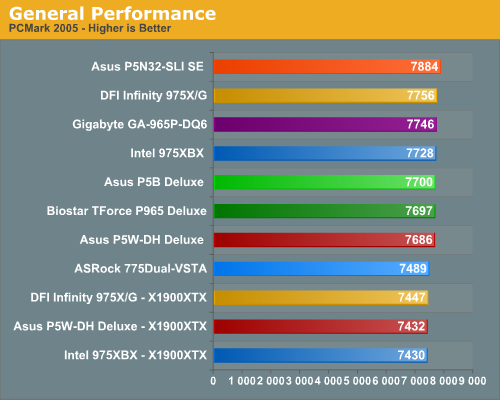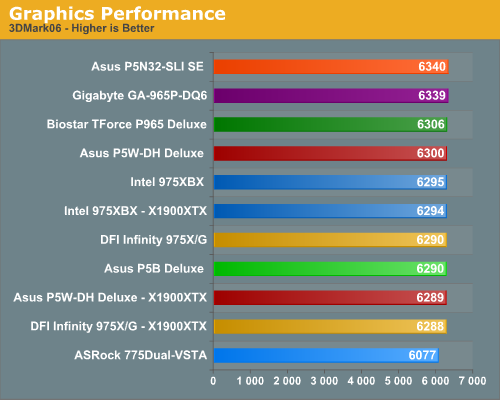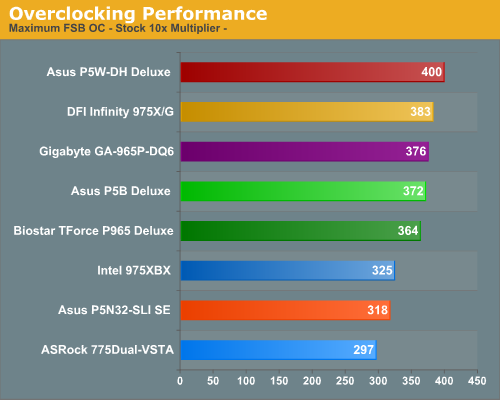Conroe Buying Guide: Feeding the Monster
by Gary Key & Wesley Fink on July 19, 2006 6:20 AM EST- Posted in
- Motherboards
General Performance
The PCMark05 benchmark, developed by Futuremark, was designed for determining overall system performance for the typical home computing user. This tool provides both system and component level benchmarking results utilizing subsets of real world applications or programs. This benchmark is useful for providing comparative results across a broad array of graphics cards, CPUs, hard disks, and memory configurations and it also includes some multithreading results. In this sense we consider the PCMark benchmark to be both synthetic and real world in nature while providing consistency in our benchmark results.

PCMark 2005 results for our test group are fairly close between the Intel chipset boards with the NVIDIA based ASUS P5N32-SLI SE taking a solid lead here due to excellent hard drive performance and multitasking scores within the benchmark. The three ATI X1900XTX equipped boards finished at the bottom of the group due to weak score results in the 2D benchmarks. Despite the close results in these tests with the Intel chipset boards, PCMark05 is still proving to be a useful overall performance benchmark. It is generally more sensitive than the older Winstones and PCMark04 to recent improvements in PC architecture.


We have replaced Winstones with 2 benchmarks that use rendering to test system performance. Cinebench 9.5 heavily stresses the CPU subsystem while performing graphics modeling and rendering. We utilize the standard benchmark demo within the program along with the default settings. Cinebench 9.5 features two different benchmarks with one test utilizing a single core and the second test showcasing the power of multiple cores in rendering the benchmark image.
While results are generally close in Cinebench, the ASUS P5N32-SLI SE tops the Dual-Core test results with the Intel 975XBX finishing a strong first in the single core tests, followed closely by the ASUS P5W-DH in both tests.
The 3DMark series of benchmarks by Futuremark are among the most widely used tools for benchmark reporting and comparisons. Although the benchmarks are very useful for providing apple to apple comparisons across a broad array of GPU and CPU configurations, they are not a substitute for actual application and gaming benchmarks. In this sense we consider the 3DMark benchmarks to be purely synthetic in nature but still valuable for providing consistent measurements of performance.

After taking a very strong first place in PCMark2005, we see the ASUS P5N32-SLI SE squeaking out a win in the 3DMark06 with an excellent performance turned in by the Gigabyte GA-965P-DQ6 for second place. The performance of the entire group was very close with the exception of the ASRock board due to its PCIe implementation (although a score over 6000 is still very respectable). The surprise was the ATI X1900XTX GPU scores as they have historically scored better in this benchmark than the NVIDIA based 7900GTX cards. We are still having conversations with ATI, but there appears to be a driver issue with the Core 2 Duo processors in our testing as the game scores will reflect the same results.
Overclocking Comparison

The overclocking capabilities we have measured thus far are with our standard E6700 CPU at a 10X multiplier. While this will not show the true FSB potential of the board, it does show a board's capability with the second highest performing Core 2 Duo and what can be expected with the fixed multiplier CPUs on average. We will be providing FSB overclocking results in our individual board reviews with the unlocked X6800. However, the only board in our testing that exceeded a 400FSB was the ASUS P5W-DH that reached 445MHz with our amazing little E6600 before running out of MCH voltage.
The NVIDIA based ASUS P5N32-SLI SE turned in a decent overclocking performance for an NVIDIA based Intel board but falls far short of the Intel chipset boards in high FSB overclocking. This situation will improve gradually over the next several months with the release of the DFI nF590 SLI board next month and then with the next true chipset revision this winter. Although the nForce4 Intel Edition board did not overclock competitively with the Intel chipsets when utilizing the FSB method, it did match the same overclocks when raising the CPU multiplier with our X6800 CPU.
The PCMark05 benchmark, developed by Futuremark, was designed for determining overall system performance for the typical home computing user. This tool provides both system and component level benchmarking results utilizing subsets of real world applications or programs. This benchmark is useful for providing comparative results across a broad array of graphics cards, CPUs, hard disks, and memory configurations and it also includes some multithreading results. In this sense we consider the PCMark benchmark to be both synthetic and real world in nature while providing consistency in our benchmark results.

PCMark 2005 results for our test group are fairly close between the Intel chipset boards with the NVIDIA based ASUS P5N32-SLI SE taking a solid lead here due to excellent hard drive performance and multitasking scores within the benchmark. The three ATI X1900XTX equipped boards finished at the bottom of the group due to weak score results in the 2D benchmarks. Despite the close results in these tests with the Intel chipset boards, PCMark05 is still proving to be a useful overall performance benchmark. It is generally more sensitive than the older Winstones and PCMark04 to recent improvements in PC architecture.


We have replaced Winstones with 2 benchmarks that use rendering to test system performance. Cinebench 9.5 heavily stresses the CPU subsystem while performing graphics modeling and rendering. We utilize the standard benchmark demo within the program along with the default settings. Cinebench 9.5 features two different benchmarks with one test utilizing a single core and the second test showcasing the power of multiple cores in rendering the benchmark image.
While results are generally close in Cinebench, the ASUS P5N32-SLI SE tops the Dual-Core test results with the Intel 975XBX finishing a strong first in the single core tests, followed closely by the ASUS P5W-DH in both tests.
The 3DMark series of benchmarks by Futuremark are among the most widely used tools for benchmark reporting and comparisons. Although the benchmarks are very useful for providing apple to apple comparisons across a broad array of GPU and CPU configurations, they are not a substitute for actual application and gaming benchmarks. In this sense we consider the 3DMark benchmarks to be purely synthetic in nature but still valuable for providing consistent measurements of performance.

After taking a very strong first place in PCMark2005, we see the ASUS P5N32-SLI SE squeaking out a win in the 3DMark06 with an excellent performance turned in by the Gigabyte GA-965P-DQ6 for second place. The performance of the entire group was very close with the exception of the ASRock board due to its PCIe implementation (although a score over 6000 is still very respectable). The surprise was the ATI X1900XTX GPU scores as they have historically scored better in this benchmark than the NVIDIA based 7900GTX cards. We are still having conversations with ATI, but there appears to be a driver issue with the Core 2 Duo processors in our testing as the game scores will reflect the same results.
Overclocking Comparison

The overclocking capabilities we have measured thus far are with our standard E6700 CPU at a 10X multiplier. While this will not show the true FSB potential of the board, it does show a board's capability with the second highest performing Core 2 Duo and what can be expected with the fixed multiplier CPUs on average. We will be providing FSB overclocking results in our individual board reviews with the unlocked X6800. However, the only board in our testing that exceeded a 400FSB was the ASUS P5W-DH that reached 445MHz with our amazing little E6600 before running out of MCH voltage.
The NVIDIA based ASUS P5N32-SLI SE turned in a decent overclocking performance for an NVIDIA based Intel board but falls far short of the Intel chipset boards in high FSB overclocking. This situation will improve gradually over the next several months with the release of the DFI nF590 SLI board next month and then with the next true chipset revision this winter. Although the nForce4 Intel Edition board did not overclock competitively with the Intel chipsets when utilizing the FSB method, it did match the same overclocks when raising the CPU multiplier with our X6800 CPU.










123 Comments
View All Comments
Gary Key - Wednesday, July 19, 2006 - link
I am surprised I did not see this posted on a news site somewhere announcing Intel has a X6600. ;-) The line was corrected this morning to (X6800, E6700, E6600) although late last night my mind was probably thinking unlocked E6600 equals X6600 for some reason. Thanks for the notice! :)
drarant - Wednesday, July 19, 2006 - link
In recent months the memory market has moved from a 1GB kit to a 2BG kit being the common memory configuration.2GB*
Excellent article, I'm assuming the OCing results were default voltages on the chipsets and/or the cpu?
drarant - Wednesday, July 19, 2006 - link
page 11, 2nd to last sentence*Patsoe - Wednesday, July 19, 2006 - link
To be honest, I would say it's quite different!
The storage controllers have been changed a lot... there is now a port-multiplier type of SiI chip that connects to one of the ICH7 ports, which provides driverless (!) RAID. Also, the previous board had a Marvell SATA/PATA controller instead of the JMicron controller.
For another difference: the new board is missing the PCIe 4x slot, too.
Anyway, thanks for the great overview! And it's amazing how fast after launch you got this up.
Wesley Fink - Wednesday, July 19, 2006 - link
Thanks for your comment. We added information to the P5W-DH page with a little more info on the differences from the earlier board.nicolasb - Wednesday, July 19, 2006 - link
...is what is the actual impact on system performance of different memory speeds and timings? Possibly you guys actually derive a direct erotic thrill simply from knowing that your memory timings are 4-3-3-9 ;-) but what the rest of us care about is whether any given timings actually provide a tangible improvement to running applications. If I spend an extra £200 on memory, am I going to get an extra 10fs in a certain game, or just an extra 1fps if I'm lucky? That's what I want to know.Conroe is a new chip and it is by no means obvious (to me, anyway) whether the speed/latency of the memory will have a greater or lesser impact on the performance of the system than is the case for Netburst or A64 chips.
So, how about re-running some of your benchmarks on one particular board and producing results for different memory speeds and latencies?
Wesley Fink - Wednesday, July 19, 2006 - link
The original plan was to publish a Conroe memory article prior to this huge motherboard and memory roundup. The move forward of the Conroe launch by two weeks shifted our schedule quite a bit, as we discussed in the Buying Guide. we have found the timings DDR2 memory can achieve give a rough idea of the performance hierarchy on Conroe. That is 1067 at 4-4-4 is a bit faster than 800 at 3-3-3 is faster than 667 3-2-3. 667 is generally faster than nything slower regardless of timings.With 13 DDR2 kits it was impossible to do proper and complete performance testing on all the memory on Conroe and still deliver an article when you want to read it. There will definitely be followup reviews of memory on Conroe anwsering your questions in detail. We knew there would be complaints from some, but we also hoped you could understnad the roundup is posting 4 days after an early Conroe launch - and you can't even buy Core 2 Duo until 7/27 or later.
We wanted to provide solid info as soon as possible for those planning a Conroe purchase. We thought our finding that almost any Elpida value DDR2 will do DDR2-800 4-3-3 at about 2.2v was big news you would want to know, we will fill in the rest of the performance data as soon as we can.
As it is the roundup is over 15,000 words and one of the largest articles ever published at AT - in word length - and we really tried to be brief in each review. We really like giving our readers exactly what they want, but sometimes the realities of time and volume shift our priorities.
Tanclearas - Thursday, July 20, 2006 - link
Although I can understand what you're saying, maybe the following should not have been included in the introductory page.I guess the only surprise was that the comparison wasn't there. :P
Honestly, I tried to jump right to that section only to find rather useless comparisons of ridiculously expensive memory (which I won't buy) and "value" (read cheap) memory (which I won't buy). Also, can you really tell me that it was much of a surprise that the expensive memory all topped out at roughly the same speed (~1100, 5-5/4-5-15)? Nor am I particularly surprised the value memory could overclock reasonably well, but how about tests of the memory that I think most of your readers are likely to buy? I've been looking at DDR2, and you can get memory rated at DDR2-800 for a little more than the DDR2-667/533 variety, and still a lot less than the DDR2-1000 modules.
I know that you were pressed for time, especially with the launch being pushed forward. I just think (and it is only an opinion) that other tests should have been given priority over the ones you've completed.
kmmatney - Wednesday, July 19, 2006 - link
Also, what motherboard was used for the DDR tests? Often, value RAM is paired with a "value" motherboard. Value RAM may not look so well when paired with a value motherboard. I'm wondering how cheap we can go for reasonable peformance :)Gary Key - Wednesday, July 19, 2006 - link
We stated at the end of page 18 that we will be publishing performance results of the value memory roundup shortly. The amount of time required to test these seven modules at four different settings in several different applications was incredible and warrants a separate article update.